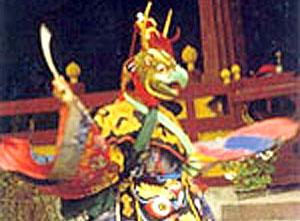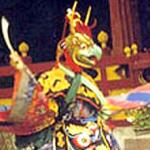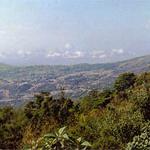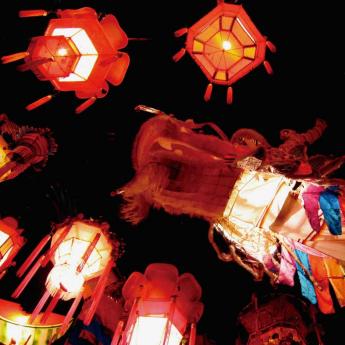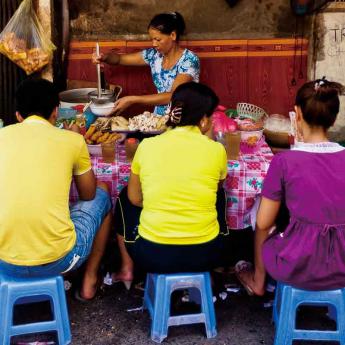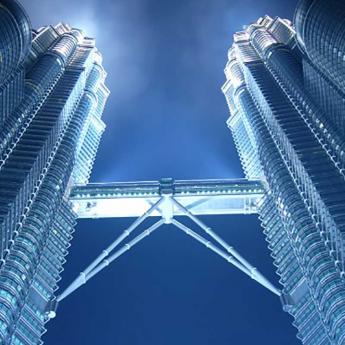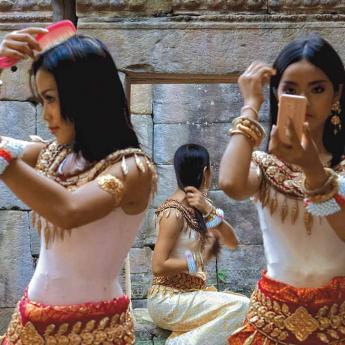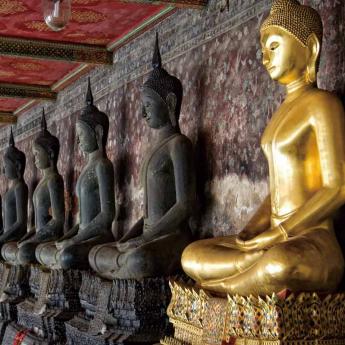Bordering Myanmar, China, Bhutan and Bangladesh, and connected to the rest of India by a mere 20 kilometers strip of land, India's North East is strikingly different compared to other parts of the country. For starters, its geographical location forming the East Himalayan region from Sikkim to the Darjeeling Hills of Bengal makes it the melting pot of many communities, faiths and cultures. Unlike our typical perception that Indians must be darkly tanned, many people in the North East are fairer than most Chinese and they have similar facial features to the Chinese too!
Many of the 166 tribes living in the North Eastern states of Assam, Arunachal Pradesh, Meghalaya, Manipur, Mizoram, Nagaland and Tripura have obviously migrated from South East Asia and China. They still share similar traditions to the people of South East Asia, with dances like the Naga dance resembling the Malaysian Iban dance and the Lama dance looking deceptively like a traditional Tibetan dance -- complete with similar costumes. Arunachal Pradesh, Meghalaya, Mizoram and Nagaland in particular are mostly inhabited by a number of native tribes. The numerous festivals and cultural activities celebrated by the tribes make it an interesting trip for many weary travelers.
The rich natural beauty, serenity and exotic flora and fauna of the area are invaluable resources for the development of eco-tourism.
Each state is unique in its own way: Assam, occupying the valleys of BrahmaputraRiver is the most densely populated and richest commercially. The neighboring Arunachal Pradesh occupies the sparsely populated foothills of the Himalayas and is one of the major tourist attractions because of its Buddhist influence. With is lush landscape and lakes, Meghalaya is famous as the wettest region of the world. Meanwhile, Nagaland has a rich history and predominantly Tibetan-Burmese population that attracts tourists. Nagaland is also the only state with English as its official language. The remaining three states of Manipur, Mizoram and Tripura make up a fascinating area consisting of green valleys with large variety of flora and fauna.
Assam
From the Indian end, Assam is the entry into the North Eastern provinces. With its economy largely dependent on the mighty BrahmaputraRiver, which also flows in Tibet, Assam's main town of Guwahati is blooms from both banks of the BrahmaputraRiver. Here, an interesting mix of the aristocratic Dravidians, the mighty Aryans and the gentle Tibetans live in harmony. Besides the historical KamakhyaTemple and ShivaTemple, the other interesting spots in Assam are situated about an hour's drive from the main town of Guwahati. An interesting diversion would be Hajo, which is the site of a Mecca-like mosque built by an Iraqi prince in the twelfth-century. A stone's throw away from the Mecca mosque is the HayagribaMadhavaHinduTemple, where a giant turtle resides.
Those who enjoy nature must travel to the KazirangaNational Park. One of the most popular wildlife parks in India, the park is easily accessible by bus from Guwahati. Spreading over an area of more than 400 square kilometers, the national park is where one of the last creatures of the prehistoric age, the famed one-horn rhinoceros lives. As the creatures move away from modern-day vehicles, the best way to see the rhinos up close is sitting on the back of an elephant. Besides the rhinoceros, you can see herds of wild elephant, the Hog deer and many water birds by taking the two-hour long jeep safari tour.
Meghalaya
Approximately three-hours by road from Guwahati is Shillong, the capital of Meghalaya which lies 1496 meters above sea level. On the way, do drop by at the town of Nongpoh to enjoy a cup of its famous tea. The city of Shillong is named after a deity known as Lei Shyllong. There is a statue of this deity at ShillongPeak, the highest point in the state of Meghalaya where travelers can enjoy a beautiful view of the entire ShillongValley. Tourist will also enjoy the local lewduh Bazaar Market. A vast variety of fruits, food and handicrafts are sold here.
Shillong town is a town of churches and waterfall. The largest church here is Cathedral of Mary Help of Christians, located on a hilltop. At its foothill is the GrottoChurch, with unique windows adding to its attraction.
A short drive away from Meghalaya will bring you to the Khasi Hills, where a unique community originating from Kampuachea (now Cambodia) (now Cambodia) in South East Asia lives. In this matriarchal society, children will follow their mother's surname and the youngest daughter will become the heir of the family's property. The men are mainly confined to doing rough jobs like tending to the fields.
Driving an hour's east from Shillong will bring you to Nartiang, the summer getaway of Jaintia kings. Nartiang's greatest attraction lies off a small dirt track, leading into a small forest. Here lies the "playground" of giants: where huge stones are arranged flat or slopping. The locals believe that this park of megaliths was constructed by a giant called U Mar Phalyngki. The tallest megalith is eight meters in height, similar to the Stonehenge in England.
Arunachal Pradesh
With rich flora ranging from alpine trees to subtropical plants, turbulent streams, lofty mountains and snow clad peaks; Arunachal Pradesh offers opportunities for hiking, rafting and mountaineering. One of the most sparsely populated of the Indian states, the people of Arunachal Pradesh can best be described as colorful and simple -- with many still living in the hills. Itanagar, its capital, is well known as a historical city. Ancient attractions in this city, once upon a time Mayapur in the fourteenth century, include the old fort (Itafort), the JawaharlalNehruMuseum and the Buddhist Monastery. Orchid lovers should drop by at Tipi, which is located along the banks of the BharaliRiver. Besides housing the largest collection of orchids in India (around 8000 hybrids), Tipi also serves as the developmental center for scientists to create new hybrids using biotechnology.
Strictly religious Buddhist travelers may wish to take a difficult journey up the snow clad ranges of Bomdila, about 2500 meters above sea-level. The entire area has strong Tibetan and Buddhist influences over the centuries, and houses many Buddhist monasteries called "Gompas" Another 10 kilometers away is Tawang, a Buddhist pilgrimage site where the Dalai Lama goes to pray. This 400-year old monastery dominates the entire TawangValley. Resembling the Tibetan mountains very closely, the Tawang Gompa has elaborately painted windows and other Tibetan motifs. Housed here is an eight meter statue of Buddha and numerous traditional paintings and manuscripts called Thaka.
Nagaland
Nagaland is blessed with beautiful valleys, high mountains, deep gorges and a rich variety of flora and fauna. True to its geographical location, this state is populated by many tribal groups. It is only in this state that travelers can see multicolored spears, bracelets, chest plates and head dress made of bamboo. According to official statistics, more than 16 tribes of Tibeto - Burman people live in Nagaland. These people are well-known as talented musicians, singers and dancers.
Due to its hilly landscape, Nagaland has one of the best trekking spots around the north-east region in the form of DzukouValley. Situated at a height of some 2500 meters above sea level, the valley is over-shadowed by a type of bamboo brush, which at first glance makes it look like a mowed lawn. Beautiful flowers like lilies and rhododendrons make the trek a very relaxing one.
However, the highlight of this state must surely be the exquisite handicrafts made by the local tribes. Such handicrafts can be purchased from Ruzaphema in Dimapur, the commercial capital of Nagaland or from the New Market in the state capital of Kohima. Colorful Naga shawls, wood carvings, bamboo creations and other handloom can be purchased from here.
Tripura
The small and fabled land of Tripura is the North Eastern state with the most pleasant weather. Somehow surrounded by Bangladesh around its north, west, south and south east, Tripura has a rich heritage from the local tribes as well as the Bengali and Manipuri people living in the state. Within the small state are plenty of attractions for the tourists: from grand palaces at Agartala to unique rock carvings in Unakoti, Debtamura and Pilak and famous Hindu and Buddhist temples including the Mata Tripureswari temple, travelers will be kept occupied during their stay in Tripura.
First up would be a trip to at least one of the elaborate palace built by the former Maharajas of India. Highly recommended is the UjjayantaPalace located in Tripura's capital city of Agartala. Built by Maharaja Radha Kishore from 1899 till 1901, this two storey mansion boosts of beautifully crafted doors, a curved wooden ceiling and a magnificently tiled floor. If it gets a bit stifling inside, enjoy the Mughal styled gardens outside, which is perfected by fountains and pools built all around.
The other two notable palaces are the KunjabanPalace (now the residence of the Governor of Tripura) situated about 1 kilometers north of the UjjayantaPalace and NeermahalPalace, a summer palace resort built in the middle of a natural lake called Rudrasagar. The NeermahalPalace is situated about 55 kilometers away from Agartala, but is well worth a visit if you could spare the time. At the moment, the palace is being renovated into a museum depicting the life of Maharajas and when the museum opens, a Light & Sound performance, showcasing the cultural heritage of Tripura will be organized nightly.
Ancient rock carvings are another major attraction in Tripura. According to the Tripura legends, Unakoti's marvelous rock carvings came about when Lord Shiva (a Hindu God) and his entourage spent a night here en route to Kashi. He ordered all his people to wake up before dawn to proceed to Kashi. However, when morning came, no one except for Lord Shiva himself got up to continue with the trip. In anger, he cursed his followers to become stone images. Today, the rock carvings in Unakoti is located in the middle of the forest, about three hours drive away from Agartala. Images found here are of two varies: rock carved figures and stone (statue-like) images. The most special of the rock carvings would be that of the 30 feet high Lord Shiva Head called "Unakotiswara Kal Bhairava" and two full-sized female figures on each side of Shiva. All the carvings and statues are worshipped by Hindu devotees during a special festival known as "Ashokastami Mela", which is held in April every year.
Among the many Hindu and Buddhist temples in Tripura, the main one must surely be MataTripureshwariTemple, which is mentioned in the Hindu mythology. Also known as Kurma Pith because of its shape resembling a tortoise, the temple is also known for its characteristic idol, the Maa Kali. This idol was once carried by the Maharajas to protect them during hunting trips or when fighting in wars.
When you are done with all the wonderful sights, a short trip across the border into Bangladesh is highly recommended, for Dhaka (capital of Bangladesh) is only about three hours by road.
Caution: Tourists need to apply for special restricted area permits to visit certain areas in Arunachal Pradesh, Manipur, Mizoram, Sikkim and Nagaland. The permits are easily available from the Immigration office, the Ministry of Home Affairs Office and all Indian high commissions abroad. Although there are sporadic skirmishes in these states, the main tourist areas are safe.
 ThingsAsian
ThingsAsian